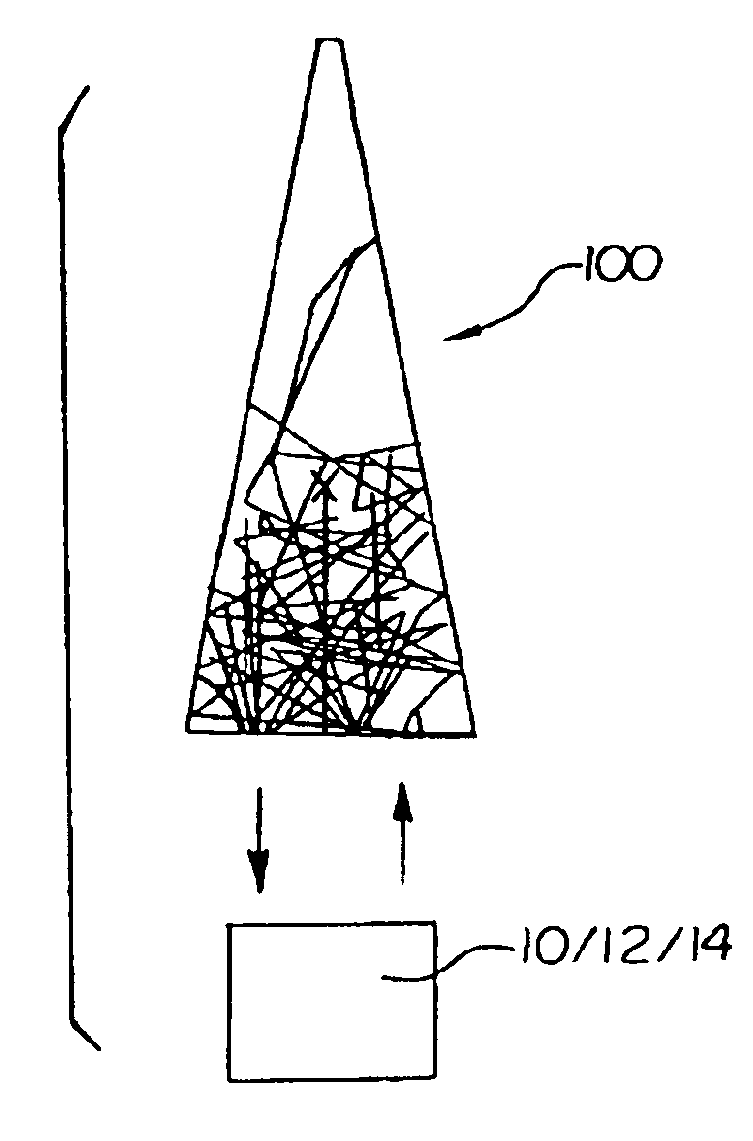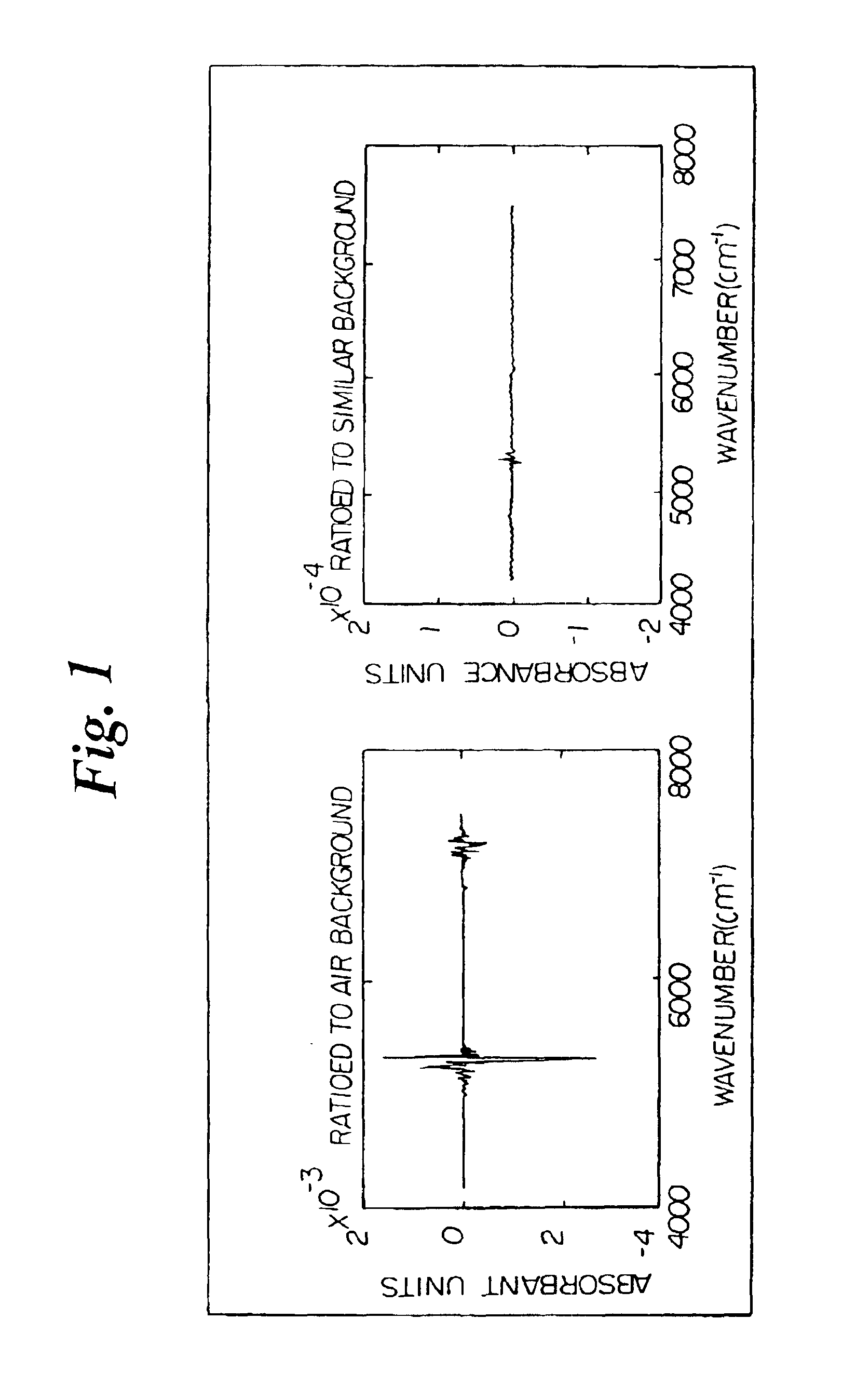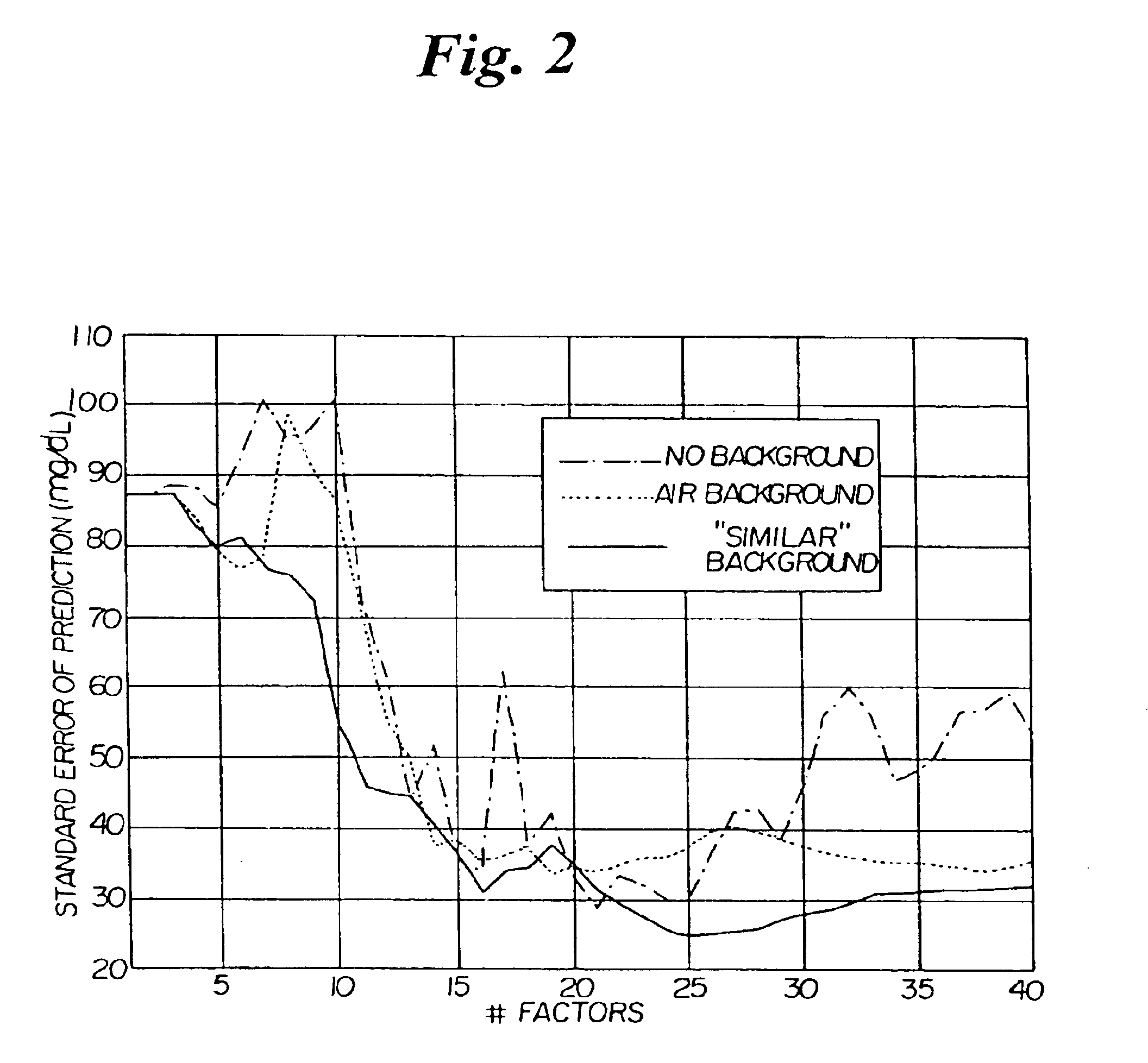[0025]The present invention provides systems and methods for establishing and / or maintaining the prediction capability over time of a multivariate calibration model designed for quantitative optical spectroscopic measurement of attributes of or analytes in bodily tissues, bodily fluids or other biological samples, including
plant samples, animal samples,
food products, and derivatives thereof (e.g., human tissue, cheese, fruit, etc.). The present invention is particularly useful in spectroscopic measurement of attributes or analytes when the spectral
absorbance of the attribute or
analyte is small relative to the background, and stable calibration samples are not readily available. To accomplish this, the present invention uses an optically similar reference sample. An optically similar reference sample is used to capture variation present in the optical
system in a manner that enables prediction performance to be maintained. The ability to capture instrument and
environmental variation is enhanced by the use of an optically similar reference sample. The optically similar reference sample will be similar to the test sample in terms of spectral
radiance. The similar background is preferably reproducible over time and is designed such that its optical properties are sufficiently matched to the sample of interest that instrument and environmental variations are captured in a similar manner in both the sample of interest and the optically similar reference sample.
[0039]The method of the present invention also provides a
system in which any of these optically similar reference sample may be used. The optical
spectroscopy system may include an
optical spectrometer having an illumination source (e.g., NIR), a
collection system, and a reference sample optically coupled (e.g., disposed adjacent) to the illumination source and
collection system. The background sample may be measured using the exact same system and methodology as that used for the test sample of interest. Alternatively, the background sample may have a separate interface with the instrument. In some embodiments, the optically similar reference sample is composed of multiple components that are simultaneously measured at different locations in the
optical path of the spectroscopic instrument. In most embodiments, the optically similar reference sample may be designed for either manual or automatic placement into the correct location for optical sampling. In the case of automatic placement, this design allows for automated obtainment of the reference spectrum and would enable calibration maintenance without the direct intervention of an operator.
[0040]The present invention also provides a method of establishing an accurate calibration model and / or maintaining the accuracy of the optical measurement system by using an optically similar reference sample as described above. In one preferred embodiment, a reference spectrum is obtained from the optically similar reference sample using an optical system and the calibration model is created or modified based on use of the calibration data and the reference spectrum. One such method is to use a linear combination of the calibration data and reference spectra. The combinations of calibration data and reference data can be done in a structured or random way. It been found that random associations work effectively and are easily implemented. The process of creating these composite data is referred to as
robustification. The resulting calibration spectra contain the reference spectra from the optically similar reference spectrum combined with calibration data. The resulting data contains spectroscopic variation associated with the instrument and environmental state of the instrument. The composite calibration data can be processed to develop a calibration model. Utilizing the newly created or modified calibration model, an
analyte or attribute of the test sample is predicted based on the test spectrum. In another preferred embodiment, the prediction of the analyte or attribute of the test sample may be based on a test spectrum that has been modified by the reference spectrum. The modified test spectrum is used as an input to create the model or as input to an existing model to predict the analyte or attribute. The modification by, or use of, the reference spectrum helps compensate for, or account for, instrument or environmental changes. In another embodiment, multiple optically similar reference samples are used to create multiple reference spectra.
[0041]Preferably, the reference spectrum is obtained just prior to obtaining the test spectrum. To increase accuracy, multiple reference spectra may be obtained near in time to obtaining the test spectrum. The multiple reference spectra may be obtained over a period of time and time-averaged or exponentially time-weighted just prior to obtaining the test spectrum.
[0042]The present invention provides a number of advantages over the prior art. As stated previously, the present invention utilizes an optically similar reference sample to allow a multivariate calibration model to be maintained over long periods of time such that it does not become invalid for future spectral predictions. The optically similar reference sample of the present invention is useful in situations where the analyte of interest has a
signal that is much smaller than the absorbing background of the sample matrix, since prior art methods do not successfully maintain calibration in the same situation. As compared to the prior art method of updating calibration, the present invention does not require periodic updating nor does it interfere with evaluation of instrument condition. As compared to the prior art method of incorporating all predictable variations into the calibration model, the present invention does not rely on any predictions, which may prove to be untrue and thereby invalidate the calibration. As compared to the prior art method of instrument-
standardization using generic and real samples, the similar background of the present invention allows the instrument state to be appropriately represented, while eliminating the need for real samples which are often unstable or not reproducible over time. As compared to the mathematical pre-
processing techniques of the prior art, the present invention allows the instrument response to be seen in the same way as the sample of interest and therefore does not rely on possibly false or inaccurate assumptions regarding instrument response. The present invention thus provides an improvement over these prior art methods because spectroscopic variation due to instrument or environmental changes are effectively captured through the use of an optically similar reference sample. The use of an optically similar reference sample enables a variety of methods to effectively compensate for unmodeled variations or artifacts, thereby allowing accurate predictions to be made.
 Login to View More
Login to View More  Login to View More
Login to View More 


